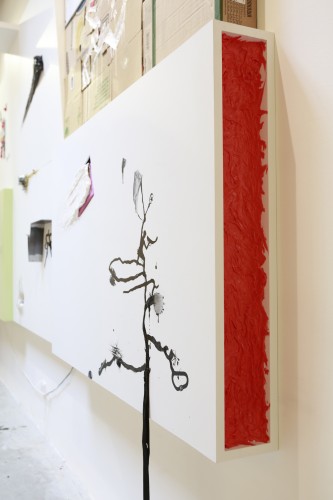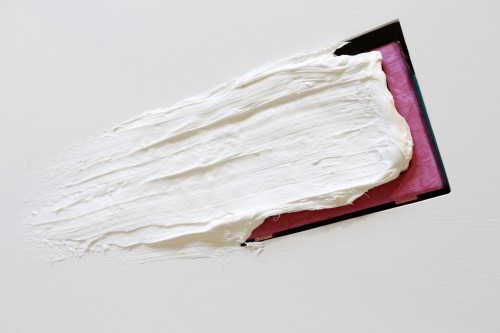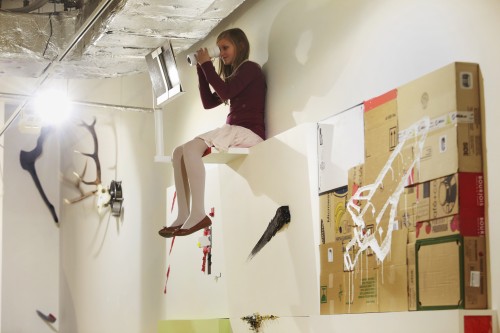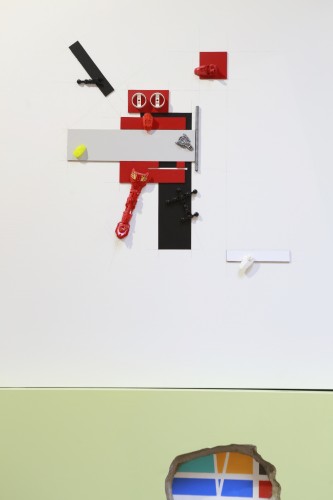Dolby Digital (original designation AC-3) is an audio coding standard for lossy audio
compression.
It is also the basic format for encoding audio on DVD and Blu-ray discs.
Dolby Painting, 2012, 200×450×20 cm mixed media.

Dolby Painting, 2012, 200 × 450 × 20 cm, mixed media. detail Earthquakes,
robbed wheel, oil on wood.
I see Dolby Painting 1/ as an index of painting techniques or a desk of a person who
thinks about painting, about its limits, possible forms and functions. It is also a
source which makes it possible to imagine what would happen if this index is
developed.

Dolby Painting, detail earthquakes, robbed wheel, oil on wood.

Dolby painting, detail of an earthquake insert with a romantic painting of the
landscape of Tuscany, Italy, a place where earthquakes often occur, oil on wood,
vibrating device.

Dolby Painting, detail of a stupa with a fragment of Sarah Morris under a fallen
layer of plaster, used as a stupa for climbing, concrete, wood.
The picture is divided into six fields that are engaged in mutual dynamic interaction,
for example, by various inclined and recessed surfaces right above it, where an
uncovered as well as slightly differentiated polychromy or materials used. This play
with the picture space activates the viewer’s perception of the nature of painting,
toying with building an illusion, layering individual genres on top of each other and
mixing seemingly incompatible cultural contexts. Disparate painting figures have the
aim to induce a situation prone to interpretation. The viewer can be a semionaut 2/,
who like particles in heavy water leaves a trail of his thought process behind him.
Lesson 1
A fragment of a Tuscan landscape floats through the picture and influences the
tonality of the field in which it is located. While interacting with the viewer, it evokes
the feeling of an earthquake that causes the disappearance of a piece of concrete The
picture is divided into six fields that are engaged in mutual dynamic interaction, for
example, by various inclined and recessed surfaces     right above it, where
an uncovered as well as slightly differentiated polychromy or materials used. This
play with the picture space activates the viewer’s perception of the nature of painting,
toying with building an illusion, layering individual genres on top of each other and
mixing seemingly incompatible cultural contexts. Disparate painting figures have the
aim to induce a situation fragment of abstraction a` la Sarah Morris can be seen in
the same visual field. Here the dominant color of the visual field is absent for a
change.

Dolby painting, detail of the side of the painting showing that the painting is filled with a paste
of red paint. To the left of it can be seen a linear painting with fragments of b&w photographs. It
is a 2D narrative collage. The last one is 3D and is represented by a black dog, which is attached to
the Dolby painting.
It was necessary to balance the weight of concrete within the diagonally laid field.
This visual segment consists of collages of cardboard boxes, while its structure is
intersected by a “lightly” outlined flying space shuttle. This huge and fast machine
breaks through the cardboard in the same direction as the shaking landscape. The
space shuttle is painted by a “negative paste”, which forms an antithesis to the simple
thick pastose brush strokes in other visual fields that are drawn in the direction
opposite to its flight.

Dolby painting, paste blinded by the radio receiver. It distorts the sound. There’s a show on the radio right now about pastiche painting.
Each of these pastes has its function related to its immediate surroundings. For example, the central black paste is a representation of weight and power of the space shuttle overcoming the gravity. Its softness is an optical illusion. Thanks to change of
material it can bear a great load and also provide climbing grips for hands and feet
for Alice 3/, who can climb to the seat above the picture. Alice casually browses a
Picasso’s monograph through a kaleidoscope, whose prism breaks the analytic
cubism into other facets; the rabbit hole becomes a singularity of both the surface and
history.

Dolby painting, detail of the stupa in ironwork. Ironwork, like reinforced concrete,
has the function of joining two structural elements, in this case two paintings. The
iron bolts and screws also serve as climbing stupas for Alice.Lesson 2
Lesson 2
The upper left part of the picture is marked by “negative” painting, falling into the
category of oblique gestures. This aggressive, dynamic punch reminiscent of
scratches from the “Monster” logo competes with another kind of aggression, which
is represented by one of the Proun Room compositions by El Lissitzky. In my version,
this futuristic picture consists of parts of dissembled Bionicle, i.e., a children’s toy
representing an android. All elements located in its immediate vicinity may be parts
jettisoned from his body. This applies to the walled fragment of a picture a` la Sarah
Morris, a “metallic color” grip for hands connecting the two middle panels as well as
the seat for Alice. Its seating part, invisible from the viewer’s point of view, consists of
a red square which throws a pink shade on the wall.

Dolby painting, detail of stupa with depression filled with black ink. Every time
Alice steps on it, she dips the tip of her slipper into the depression and the ink spills
out a little.
1/ Like, for example, with the ABS series, I borrowed a term from the field of
technology, in this case from electrical engineering. Thus Dolby Painting in this case
can be viewed as a medium in which I try to suppress noise (errors). However,
according to today’s standards it is an outdated means, so this attempt is bound to
fail, causing unexpected turbulences which are the real subject of my interest. The
implementation of my experiments led me, for example, to a redefinition of some
modernist strategies, some degradation media changes, reflections on the
accumulation of time in the past, the activation of color hidden in the mass,
individualization of ornamental elements, dynamic tiles, crystallization and, by
extension, the activation of minimalism arising from chaos, to an attempt at
implementation of Taliban calligraphy, the confrontation of action painting with
action movie, Russian avant-garde with Hollywood, the juxtaposition of Pollock
and Spiderman, Chaplin and Malevich, Picasso and Alice in Wonderland, Lissitzky
and Bionicle, EU summit and the Last Supper, etc…
Dolby painting, the detail of the abstract figure in the painting depicts the connection of two
principles – El Lisitsa's constructivism and foldable, childlike action figures – Bionicle, created by
Lego.
2/ Semionaut is a viewer who is equal to the artist when moving between signs.
Bourriaud – Relational Aesthetics. Semionaut. The contemporary artist is a
semionaut, he invents trajectories between signs.
3/ Alice in Wonderland. The author is Lewis Carrol, an English mathematician and
logician.
Antigraph
2014
mixed media
435 x 200 x 17 cm
The diptych is a “Dolby painting” in which “continuous curves” inspired by a comics
story are applied. This “drawing by painting” consists of open graphemes, repeated in
different variations in the image. At various points of the pathways, especially where
they intersect, there can occur an associative reading of the story by means of
narrative, photographic collage details. Graphemes, also thanks to the pathways
which go beyond them, reach out of the images through 3D readymade objects,
inviting the audience to action.

Antigraph, 2014, mixed media, 435 x 200 x 17 cm, detail of a shelf with a book
about minerals. Above the shelf there are small spots of black paint. Due to the thick
ropes coming out of them, the specks become potentially usable. To the left is an
abstract detail reminiscent of nature.

Antigraph, 2014, mixed media, 435 x 200 x 17 cm, whole.

Antigraph, 2014, mixed media, 435 x 200 x 17 cm. Detail of the head of a
photographic tripod

